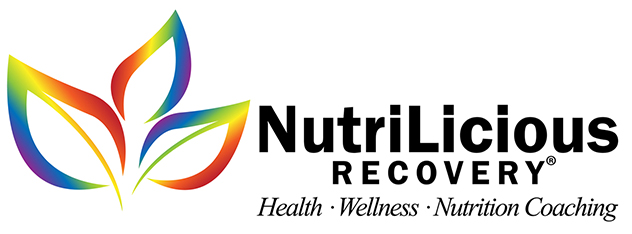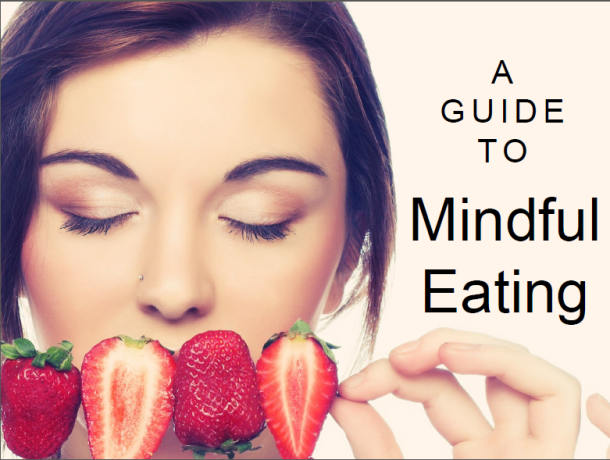
by dnshah | Jul 8, 2018 | Age Defying, Diet and Weight Loss, Health and Wellness Tips, Stress Management
People are still conflicted on taking a daily vitamin or not. Most people tell me they prefer just eating nutritious meals and forgoing a supplement. Many people tell me they just don’t believe in multivitamins. I know that while it is BEST to get everything you need from your foods – the reality is it is too difficult unless you are logging everything you eat and calculating your last meal based on what you still need to eat. In today’s world, that just too difficult!
Our current American Dietary Guidelines indicate that supplements may be useful for providing the nutrients you may be lacking from diet alone. So consider taking that multivitamin – even if not every day. Current guidelines credit good nutrition with each of these benefits:
- Healthy aging. Over time, our bodies have a harder time absorbing nutrients. That’s why after the age of 50, some of our nutrient needs go up. In these cases, taking a multi-vitamin/multi-mineral supplement can improve deficiencies.
- Elimination Diet Catch-Up. For some people on elimination diets, or for some that are reducing a food group (ie dairy), it becomes more challenging to get all the nutrients needed daily. The multi-vitamin allows a little catch-up for those that are temporarily not eating all foods or all food groups. (ie Paleo diets are short on calcium and vitamin D; Vegetarian/Vegan diets may be short on iron and vitamin B12).
- Hitting the RDA. The path to consistently hitting your RDA targets is to have a great vegi-regimen, which means loading up on fruits, vegetables, whole grains, and legumes/lean protein. Despite vitamin and mineral fortification of many common Western staples, some US adults are still failing to meet their daily requirements for vitamins and minerals. In an effort to avoid illnesses from routine deficiencies, the multivitamin regimen is strategic.
- Energy Boost.In today’s world, everyone can use an energy boost. This only comes when all of our cells, tissues, and organs are working optimally. Our cells need oxygen, vitamins, minerals, and rest to power through our days. So in addition to adequate rest and fluids, the multi-vitamin and multi-mineral supplements are a path to functioning optimally.
- Managing stress.Every person handles a certain amount of stress. But when daily life is creating more stress than you can handle, the daily vitamins and minerals support and preserve your brain’s cognitive processes. So a supplement (which includes B vitamins) is a good idea to reduce stress and support a healthy mood.
Remember to check with your doctor before starting a vitamin regimen and ensure there are no contra-indications with any current medications you may be taking or any foods you routinely eat.
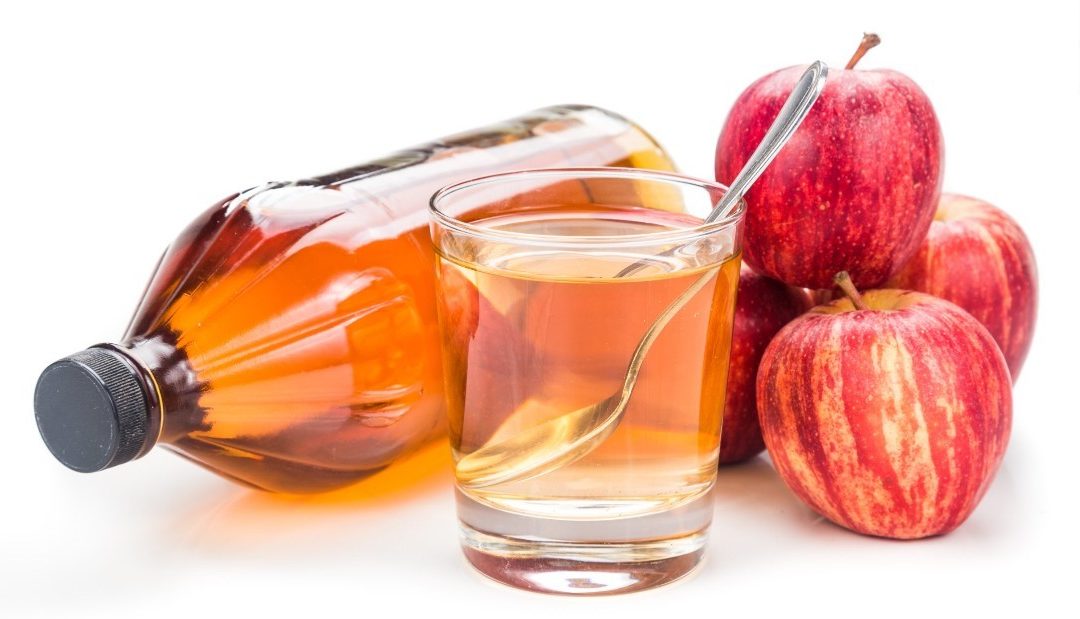
by dnshah | Jul 8, 2018 | Age Defying, Diet and Weight Loss, Health and Wellness Tips, Obesity, Stress Management
Please note that before anyone changes their diet that they should speak to their doctor about their health goals and their desire to use ACV to reach them.
Losing weight is a cumulative process involving one’s dietary consumption, lifestyle, fitness/activity levels, stress, sleep, and digestion. The point being that just adding ACV into one’s diet does not imply one will automatically lose weight. That said, there is a 2017 study involving rats showing that ACV attenuates oxidative stress and reduces the risk of obesity. No word on how this impacts humans, but I believe ACV could help humans similarly as long as there is a moderation of food and ample movement, sleep, and intent to lose weight. The ACV dosage for weight loss is 2 teaspoons diluted in 16 ounces of water daily. Food should be combined with a protein (at every meal) for the metabolism boost needed to change the way the body processes food. A sensible weight loss diet consists of adequate protein, carbohydrates, and healthy fats. To understand how much is recommended daily, one should seek the support of a nutritional therapist or dietician.
One should NOT combine ACV with foods with baking soda. Mixing vinegar and baking soda can cause an acid-base reaction creating carbon dioxide inside the body.
ACV can prove to aid in weight loss when combined with a SENSIBLE nutritious diet, moderate exercise, and adequate sleep. For many people it work as a natural appetite suppressant allowing one to reduce their appetite and shrink their stomach. Again it is one factor in weight loss – and there are many others (quantity of food, stress, sleep, activity, etc.).
Aside from dietary reasons, ACV is used for a number of health/cleaning/detox goals, and the dosage varies for each goal. For ramping up the antimicrobial capacity to best manage candida albicans (yeast that causes infections in the mouth, intestinal tract, and/or vagina), the dilution would be 1:2 ACV. The dilution would be 1:50 to inhibit the growth of E-coli. Of course many people use ACV diluted in equal parts for gargling to relieve sore throat or bad breath. Those suffering from acid reflux have experimented with ACV to help the root cause of their reflux. For those that have reflux due to insufficient acid, the ACV helps balance out their acids. The dose for that is 1 teaspoon of ACV followed by a glass of water. Daily ingestion may fight off sinus infections by cleaning the lymphatic system.
In fact there is also an “Apple Cider Vinegar Detox” where one wants to clean the lymphatic and digestive systems. It involves ingesting ACV 3 times a day diluted in water (as a tea)
Some get a benefit from ACV by topically applying it… for relief of itching of bug bites, or on the skin directly, or rinsing their hair with it after a shampoo. It can also help with teeth stains by rubbing it into the stain on the tooth and then rinsing well with water.
Aside from consumption and topical use of ACV, it is a great cleaning agent combined with water. And this cleaner is highly recommended with little ones running about during the cleaning. Because if they come into contact with the cleaning solution, there is little negative effect even if swallowed for most.
That said, ACV is not for everyone; some are particularly sensitive to it (those sensitive to apples cannot partake). Regular consumption of ACV may cause tooth enamel erosion, so it is wise to use a straw or rinse the mouth after consuming it. It could interact with medication (including diuretics and insulin) so talk to your doctor if you are on prescription medications before using ACV. And finally ACV is acidic in nature so it could irritate the throat and stomach, especially if taken on an empty stomach. Dilution is key to avoid this irritation so drink plenty of water if irritation occurs.
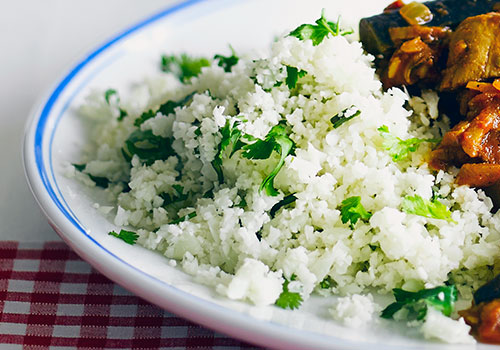
by dnshah | Mar 8, 2018 | Age Defying, Diet and Weight Loss, Health and Wellness Tips, Main Dishes, Obesity, Recipes
I have tried cauliflower “rice” with other curries and I really didn’t notice too much of a difference in taste. If you are a rice fanatic and you need your rice daily, you will definitely notice a difference – but consider swapping it out occasionally for nutritious variety and gain. And if you don’t eat it every day, and can add more flavor and taste with side dishes, I think it is a phenomenal swap! Here’s the nutritional breakdown
| 100g of each |
|
|
|
|
|
|
|
|
|
Fiber |
Calories |
Protein |
Carbs |
Sugars |
Fat |
Vitamins |
Minerals |
| Cauliflower |
3 |
25 |
2 |
5 |
2 |
0.4 |
C,B-6,Folate |
K,Mn |
| White Rice |
0.4 |
130 |
2.7 |
28.2 |
0.1 |
0.3 |
Folate, Thiamin, Niacin, B-6 |
Mn, Se, Fe |
| Brown Rice |
3.4 |
362 |
7.5 |
76.2 |
1.1 |
2.7 |
B-6,Folate, Niacin |
Cu, Mg, Mn, P, Zn |
|
|
|
|
|
|
|
|
|
|
So choosing cauliflower over white rice helps us because our bodies need more fiber, and cauliflower packs more than 7x what white rice gives us. Most of us would rather spend our calories elsewhere than rice or cauliflower, and cauliflower is 5x less calories – for the same 100 gram comparison. Cauliflower is 5x lower in carbs. It provides some natural sugar – which is okay, and it provides some vitamin C and potassium which is needed for our immune systems daily.
Other fringe benefits include faster prep time because it is actually faster to food process and oven roast cauliflower than to boil long-grain white rice. Cauliflower is part of the cruciferous family of vegetables touted for their anti-cancer properties. Other health benefits for cauliflower over white rice include collagen production, good blood clotting, blood pressure regulation, bone health, and a metabolism boost!
So overall this particular swap is a great one!
Why would someone not want to choose cauliflower over rice? If you have a food sensitivity to cauliflower, you’re better off switching between white and brown rice! If you have thyroid issues, you have to watch overeating of goitrogenous vegetables, like those in the cruciferous family. If the cauliflower is cooked, it should not pose a health issue.
To make cauliflower rice, simply process the cauliflower (food processor) until it is rice-sized. Then boil in stock or saute with other flavors for 2 minutes. Voila! you have a cauliflower rice.
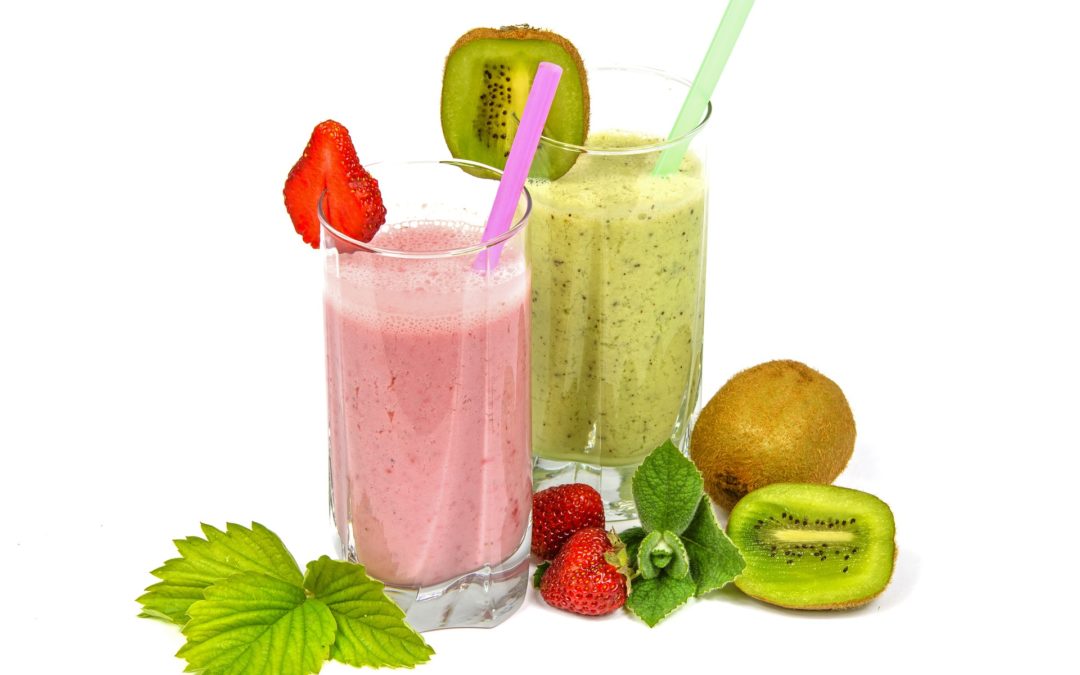
by dnshah | Mar 8, 2018 | Age Defying, Diet and Weight Loss, Health and Wellness Tips, Obesity, Stress Management
One of the things that most of my clients love to incorporate is a nutrient dense breakfast protein smoothie. How healthy are protein shakes?
They are only as healthy as the ingredients that go into them! So if we’re talking buying a bottle from the store – chances are taste becomes more important than health. When a brand wants to sell their product, they have to ensure people understand it, can afford it, like it, and will buy it. And then the focus is on repeat business (taste). I have not found any ready-made protein smoothies that are NOT full of sugars and additives. It’s the nature of the business.
For this reason, I advocate for MAKING homemade protein smoothies. This means that you have to invest in some protein powder varieties (whey protein, pea protein, soy protein, etc.), and some fruits/vegetables that blend well together. In addition the protein smoothie is an excellent carrier for other superfoods (nuts, seeds, fiber, spices, fats, omega-3s, herbs) that add to the taste as well as the nourishment.
What are the benefits of the concept of protein smoothies? When incorporated on a daily or almost daily basis, they provide a convenient (could be packed to-go in the early mornings) medium of consuming a nutrient rick breakfast every day. Most of us don’t have a lot of extra time in the mornings, and many of us are on the go. The idea of blending some healthy foods together into a shake and drinking it becomes one that many people are willing to try. Once they realize it satisfies them, is easy to make, easy to digest, hydrates them, is versatile, has endless varieties depending on various ingredient combinations, prevents the munchies later, and empowers some weight loss in a comfortable way – many of clients are on-board to do it long term. And I didn’t even mention that it becomes very easy to add superfood key ingredients (turmeric, psyllium husk, flax seeds, etc) so that that decadent protein smoothie becomes an immune booster, and a natural detoxifier.
What are examples of the “better” ones? The “better” ones are homemade, have no added refined sugar, and have no dairy. They are based in water and have 30-40% fruits, 40-50% vegetables, and the remainder is filled with protein and superfood toppings. Ideally you drink a different flavored/colored smoothie every day/week so the body gets a chance to get the various nutrition it needs in a week.
What are the drawbacks? It takes some time to buy and prepare the foods you would want to use in the quick morning smoothie blends. But I find that once/week or once/month, you can buy, wash, cut, and pack individual ziplocs of the smoothie ingredients and then FREEZE them. This way in the morning, you just grab a bag – add protein, seeds, nuts, husk, and blend. Voila – you’re done!
Do they help with building muscles? The different qualities of each protein would help in different ways – but generally speaking increasing your protein intake would help to repair muscles during a process of building or recovery. This means a protein smoothie is useful BEFORE or AFTER a workout. Is there a healthier alternative? The only way to get the benefits discussed are to ingest real foods. It may take a while to actually eat all of these things during the day – and you have to find the time to prep and eat them; or come up with a system that you quickly blend these amazing foods and drink them to jump start your day. My husband and I can vouch for our mornings being complete with our smoothies. Additionally I talk about protein smoothies in my TedX Talk too. They are a means of great power, energy, and recovery.

by dnshah | Mar 8, 2018 | Diet and Weight Loss, Health and Wellness Tips
Almost 33% of Americans are affected by hypertension (HTN), which is a major risk factor for heart disease and mortality. While we still don’t know the exact cause for HTN, we know that it is associated with a fundamental defect in the kidneys to excrete sodium. This “salt sensitivity” is measurable and seen with increased salt intake leading to increased blood pressure. Salt sensitivity is seen in older adults, African Americans, and sufferers of kidney issues, diabetes mellitus, or metabolic syndrome.
With a recent awareness of the impact of our microbiomes, the microscopic bacteria colonies that life in our guts, we’ve learned that it plays a key roles in obesity, type 2 diabetes, and atherosclerosis. More recently in animal studies and a small human trial, we see that the microbiome plays a role in salt sensitive hypertension also. It seems a diet high in salt depletes the Lactobacillus species of bacteria in the gut, and that can increases risks of autoimmunity and high blood pressure.
Until a more lengthy research study is performed, hopefully we can begin to understand the dangers of a salt shaker sitting innocently at the dinner table. We can acclimate our taste buds to increased salt, and vice versa also! Gradually reducing the salt in our foods and adding in flavorful herbs and condiments allow our taste buds to appreciate varying flavors and great taste without putting our health at risk for HTN, cardiovascular issues, and autoimmunities.
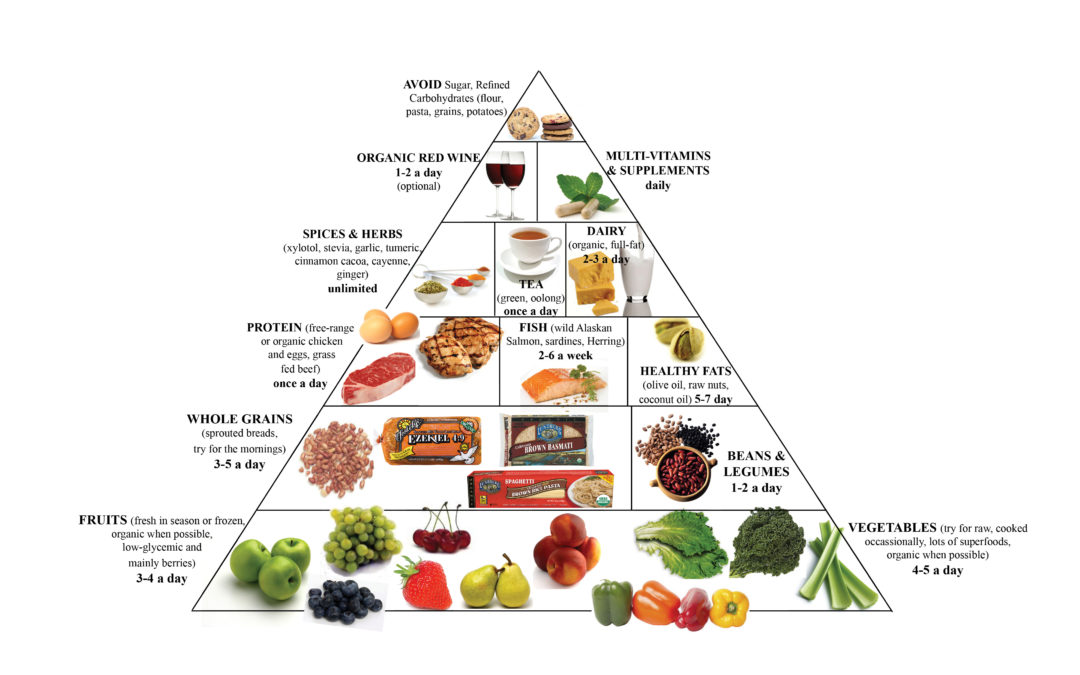
by dnshah | Mar 8, 2018 | Diet and Weight Loss, Health and Wellness Tips, Obesity
In the 1970s the old food pyramid had the simple code 4432, which defined the 4 main food groups and how many daily servings you should have. It translated into 4 servings of Fruits/Vegetables, 4 servings of Grains, 3 servings of Milk/Dairy, and 2 servings of Meats. The food pyramid has continued to evolve since then. Today’s food pyramids vary. The one I like the most is from a health coaching site that is about more than nutrition – it’s also about anti-inflammation. We now know that chronic inflammation spells out illness in the long run, so as long as we distance ourselves from it, we will ensure good health. Today’s food pyramid encompasses a dozen food groups too. It calls for 4-5 daily servings of vegetables, 3-4 daily servings of fruits, 3-5 daily servings of whole grains, 1-2 daily servings of beans or legumes, 5-7 daily servings of healthy fats, 1 daily servings of meats, 2-6 servings of fish, 1 daily cup of tea, 2-3 servings of dairy, and no more than 2 glasses of red wine per day. There are also suggestions to add in healthy herbs and spices as desired. Our pyramid is abundant with tastes, textures, and colors which means a variety of antioxidant opportunity. For assistance on how to get all the nutrition you need from your daily meals, consider getting a single consult and having a weekly meal plan customized for your lifestyle. Make an appointment today!

